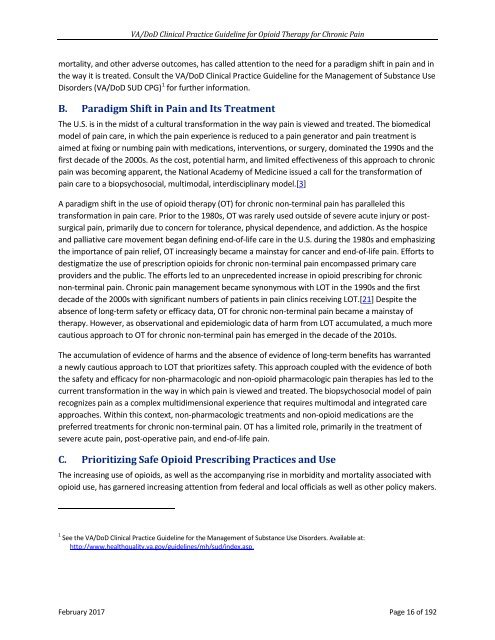VA/DoD CLINICAL PRACTICE GUIDELINE FOR OPIOID THERAPY FOR CHRONIC PAIN
2lfFhbO
2lfFhbO
You also want an ePaper? Increase the reach of your titles
YUMPU automatically turns print PDFs into web optimized ePapers that Google loves.
<strong>VA</strong>/<strong>DoD</strong> Clinical Practice Guideline for Opioid Therapy for Chronic Pain<br />
mortality, and other adverse outcomes, has called attention to the need for a paradigm shift in pain and in<br />
the way it is treated. Consult the <strong>VA</strong>/<strong>DoD</strong> Clinical Practice Guideline for the Management of Substance Use<br />
Disorders (<strong>VA</strong>/<strong>DoD</strong> SUD CPG) 1 for further information.<br />
B. Paradigm Shift in Pain and Its Treatment<br />
The U.S. is in the midst of a cultural transformation in the way pain is viewed and treated. The biomedical<br />
model of pain care, in which the pain experience is reduced to a pain generator and pain treatment is<br />
aimed at fixing or numbing pain with medications, interventions, or surgery, dominated the 1990s and the<br />
first decade of the 2000s. As the cost, potential harm, and limited effectiveness of this approach to chronic<br />
pain was becoming apparent, the National Academy of Medicine issued a call for the transformation of<br />
pain care to a biopsychosocial, multimodal, interdisciplinary model.[3]<br />
A paradigm shift in the use of opioid therapy (OT) for chronic non-terminal pain has paralleled this<br />
transformation in pain care. Prior to the 1980s, OT was rarely used outside of severe acute injury or postsurgical<br />
pain, primarily due to concern for tolerance, physical dependence, and addiction. As the hospice<br />
and palliative care movement began defining end-of-life care in the U.S. during the 1980s and emphasizing<br />
the importance of pain relief, OT increasingly became a mainstay for cancer and end-of-life pain. Efforts to<br />
destigmatize the use of prescription opioids for chronic non-terminal pain encompassed primary care<br />
providers and the public. The efforts led to an unprecedented increase in opioid prescribing for chronic<br />
non-terminal pain. Chronic pain management became synonymous with LOT in the 1990s and the first<br />
decade of the 2000s with significant numbers of patients in pain clinics receiving LOT.[21] Despite the<br />
absence of long-term safety or efficacy data, OT for chronic non-terminal pain became a mainstay of<br />
therapy. However, as observational and epidemiologic data of harm from LOT accumulated, a much more<br />
cautious approach to OT for chronic non-terminal pain has emerged in the decade of the 2010s.<br />
The accumulation of evidence of harms and the absence of evidence of long-term benefits has warranted<br />
a newly cautious approach to LOT that prioritizes safety. This approach coupled with the evidence of both<br />
the safety and efficacy for non-pharmacologic and non-opioid pharmacologic pain therapies has led to the<br />
current transformation in the way in which pain is viewed and treated. The biopsychosocial model of pain<br />
recognizes pain as a complex multidimensional experience that requires multimodal and integrated care<br />
approaches. Within this context, non-pharmacologic treatments and non-opioid medications are the<br />
preferred treatments for chronic non-terminal pain. OT has a limited role, primarily in the treatment of<br />
severe acute pain, post-operative pain, and end-of-life pain.<br />
C. Prioritizing Safe Opioid Prescribing Practices and Use<br />
The increasing use of opioids, as well as the accompanying rise in morbidity and mortality associated with<br />
opioid use, has garnered increasing attention from federal and local officials as well as other policy makers.<br />
1 See the <strong>VA</strong>/<strong>DoD</strong> Clinical Practice Guideline for the Management of Substance Use Disorders. Available at:<br />
http://www.healthquality.va.gov/guidelines/mh/sud/index.asp.<br />
February 2017 Page 16 of 192


